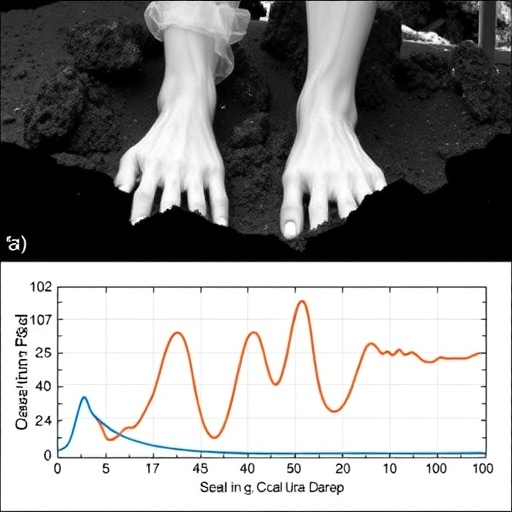Recent advancements in coal reservoir studies are providing substantial insights into the adsorption energy variation across different coal facies. The implications of such variations have far-reaching effects, especially in the context of energy production and environmental management. A recent study led by Chang, Ming, and Zhang published in Nature Resources Research has explored this intricate relationship using sophisticated methods involving logging curves to predict spatial distributions and variations in adsorption energy.
Understanding adsorption energy is crucial as it determines how well gas molecules can adhere to the coal surfaces, which directly influences the extraction efficiency of methane from deep coal reservoirs. Traditional methods often fail to capture the complexity of coal facies, leading to suboptimal resource utilization. The researchers aimed to address this knowledge gap, emphasizing the need for a refined approach that integrates geological characteristics with modern analytical techniques.
One of the study’s significant breakthroughs is the systematic approach to evaluating different coal facies. By utilizing logging curves—essentially continuous measurements taken from the earth as boreholes are drilled—the researchers could construct a detailed picture of the subsurface coal formations. This method allows for a non-destructive means of probing into geological layers, retaining the integrity of the formation while gathering critical data. The integration of such logging data with predictive models enables a more precise assessment of variants in adsorption energy.
Moreover, the researchers outlined a methodology that combines geological modeling with statistical analysis to interpret the variations in adsorption energy among distinct coal types. This approach not only helps in identifying the specific conditions under which different coal facies form but also reveals the potential for varying gas extraction efficiencies. The implications of these findings resound loudly across the energy sector, especially in the ongoing transition toward sustainable energy sources.
A focal point of the study is the correlation between the mineral composition of the coal and the adsorption characteristics. The researchers meticulously analyzed how the presence of certain minerals impacts gas adsorption capacity, thereby illuminating the complex interactions at play. Mineralogy often dictates porosity and permeability in coal seams, which in turn govern the potential for gas accumulation in these reservoirs. Understanding these relationships can lead to tailored extraction techniques that take into account the unique attributes of each coal facies.
The findings, which suggest that not all coal types behave uniformly under similar conditions, challenge traditional paradigms of coal bed methane extraction. For instance, certain facies may exhibit higher adsorption energies, thereby enhancing gas retention, while others may facilitate easier extraction due to lower energies. This stratification of performance underscores the necessity of employing advanced predictive modeling techniques to optimize resource extraction strategies tailored to specific site conditions.
The researchers demonstrated the practicality of their findings by applying their predictive models to case studies from existing coal reservoirs. This real-world application highlighted the accuracy and applicability of the developed approach while providing invaluable benchmarks for future studies. By showcasing how logging curves can inform both theoretical understanding and practical applications, this research piece stands at the intersection of geology, engineering, and environmental science.
Additionally, the integration of machine learning techniques into the analysis opens the door for even more sophisticated modeling capabilities. With the ability to analyze vast datasets, machine learning algorithms can uncover complex patterns that human analysts might overlook. As these algorithms evolve, they will provide enhanced predictive power, enabling operators to make informed decisions that maximize both safety and efficiency in coal bed methane recovery.
In light of climate change and the global push towards alternative energy sources, understanding the dynamics of coal reservoirs becomes even more important. The study emphasizes that while coal is often demonized as a significant contributor to greenhouse gas emissions, it still plays a crucial role in energy production. By optimizing methane extraction and minimizing waste, the research advocates for a more responsible harnessing of fossil fuels while paving the way for a cleaner future.
The versatile applications of the research findings extend beyond methane extraction. By gaining a deeper understanding of coal facies, industries involved in carbon capture and storage can also benefit from this knowledge. Improved insights into gas retention behaviors and mineral interactions can inform strategies that enhance the storage and management of carbon emissions from various energy systems.
Ultimately, Chang, Ming, and Zhang’s research sheds light on the complex interplay between geology and energy resources, enhancing our ability to harness coal more responsibly while mitigating its environmental impact. This study serves as a stepping-stone for further investigations into unconventional gas reservoirs and their potential as transitional energy sources.
With its rigorous methodology and practical applications, this research piece not only enhances the scientific understanding of coal reservoirs but also emphasizes the need for informed, data-driven approaches in the energy sector. As the world grapples with the dual challenges of energy security and climate change, studies like this will be essential in guiding the responsible utilization of natural resources.
In summary, the exploration of adsorption energy variation and prediction across coal facies marks a significant advancement in resource management strategies. By effectively marrying geological insights with cutting-edge analytical techniques, researchers are paving the way for a more efficient and sustainable energy landscape. This work stands as a testament to the power of interdisciplinary approaches in addressing some of the most pressing challenges facing our planet.
Subject of Research: Adsorption Energy Variation and Prediction of Different Coal Facies in Deep Coal Reservoirs.
Article Title: Adsorption Energy Variation and Prediction of Different Coal Facies in Deep Coal Reservoirs and Spatial Distribution Using Logging Curves.
Article References:
Chang, X., Ming, D., Zhang, J. et al. Adsorption Energy Variation and Prediction of Different Coal Facies in Deep Coal Reservoirs and Spatial Distribution Using Logging Curves.
Nat Resour Res (2025). https://doi.org/10.1007/s11053-025-10515-9
Image Credits: AI Generated
DOI:
Keywords: Adsorption energy, coal facies, deep coal reservoirs, logging curves, methane extraction, geological modeling, mineral composition, machine learning, carbon capture, energy sustainability.




